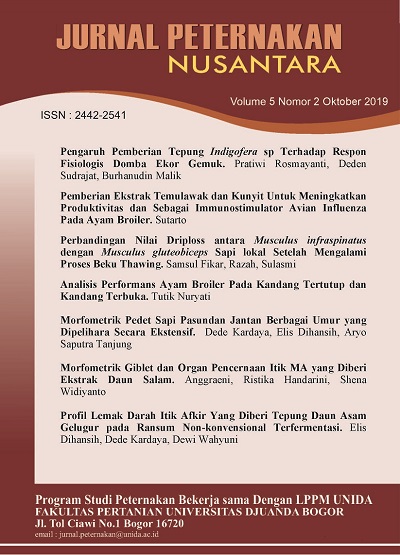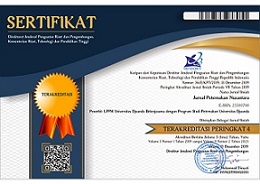COMPARISON OF DRIP LOSS VALUES BETWEEN MUSCULUS INFRASPINATUS AND MUSCULUS GLUTEOBICEPS LOCAL CATTLE AFTER FROZEN-THAWING PROCESS
DOI:
https://doi.org/10.30997/jpnu.v5i2.1842Abstract
Aimed this study to know about percentage of drip loss at Musculus infraspinatus and Musculus gluteobiceps local cows after freeze-thawing. Musculus infraspinatus and Musculus gluteobiceps is cutting about 50-75 gram for 15 sample. All sample is weighing for the first weigh and then freezing until 24 hours. After that thawing the sample until 24 hours too in refrigerator. Repeat this process until four season. The finally we can read drip loss in Musculus gluteobiceps is the bigger at process freeze-thawing fourth. Duncan test showing a diferent percentage of drip loss after freeze-thawing.
Key words : Drip loss, freeze-thawing , Musculus infraspinatus and Musculus gluteobiceps
Downloads
References
Girard, J.P. 1992. Tchnology of Meat and Meat Products. Ellis Horwood, New York.
Lawrie, R. A. 1995. Ilmu Daging. Diterjemahkan oleh Aminuddin Parakkasi. Edisi ke lima UI Press, Jakarta
Moran, E. T. 1977. Growth and Poultry Meat Production. New York
Muchenje V, K Dzama, M Chimonyo, PE Strydom, A Hugo andJG Raats, 2009. Some biochemical aspects pertaining to beef eating quality and consumer health:A review. Food Chem, 112: 279-289.
Offer, G. and J. Trinick. 1983. The mechanism of water holding in meatthe swelling and shrinking of myofibrils. Meat sci.(8):245-281.
Pogorzelska J, J Miciński, H Ostoja, IM Kowalski, J Szarek and E Strzyżewska, 2013. Quality traits of meat from young Limousin, Charolais and Hereford bulls. Pak Vet J, 33(1): 65-68.
Rahim S. 2009. Pengaruh Jenis Otot dan Lama Penyimpanan terhadap Kualitas Daging Sapi. Jurnal Ilmiah Ilmu-Ilmu Peternakan. 12(2); 67-71
Saraswati. 1989. Mengawetkan Daging. Bhratara, Jakarta.
Strange, E. D. 1987. Quantitation and characterization of drip from frozenthawed and refrigerated pork liver. J. Food Sci. (52): 910-915
Soeparno. 2009. Ilmu dan teknologi daging. Gadjah Mada University.Press. Yogyakarta.
Varnam, A. H and J. P. Shutherland. 1995. Meat and Meat Product. Chapman and Hill.Co.
Vianti. 2007. Pengaruh Metode Thawing Terhadap Kualitas Fisik Daging Sapi pada Pasca Pembekuan. Skripsi. Fakultas Peternakan Universitas Jambi, Jambi.
Winarno.F.G.(1996). Ilmu Pangan. Universitas Indonesia Press. Jakarta.
Lawrie, R. A. 2003. Ilmu daging. Penerjemah: Aminuddin Parakkasi. Universitas Indonesia Press. Jakarta.
Downloads
Published
How to Cite
Issue
Section
License
Authors who publish with Jurnal Peternakan Nusantara agree to the following terms:
- Authors retain copyright and grant the journal right of first publication with the work simultaneously licensed under a Creative Commons Attribution 4.0 International License that allows others to share the work with an acknowledgement of the work's authorship and initial publication in Jurnal Peternakan Nusantara.
- Authors are able to enter into separate, additional contractual arrangements for the non-exclusive distribution of the journal's published version of the work (e.g., post it to an institutional repository or publish it in a book), with an acknowledgement of its initial publication in Jurnal Peternakan Nusantara.
- Authors are permitted and encouraged to post their work online (e.g., in institutional repositories or on their website) prior to and during the submission process, as it can lead to productive exchanges, as well as earlier and greater citation of published work.










